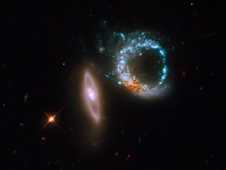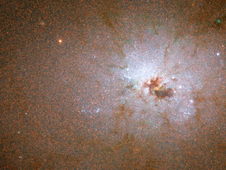Follow the Mission

STS-125
Atlantis and crew return to Hubble to upgrade the telescope.
› Mission and Crew | › Crew Journals
› Mission Summary (444 KB PDF)
› SM4 Media Guide (22 MB PDF)
Connect to the Mission
Hubble Science
Mission News
-

Hubble Scores a Perfect Ten
Just a few days after the orbiting observatory was brought back online, Hubble aimed its sights on a pair of gravitationally interacting galaxies.
-

Hubble Status Report #7
The current primary camera on the Hubble Space Telescope is now back in active operation and will resume science observations shortly. Just before 9:30 a.m. EDT on October 25, 2008, on board Hubble, the telescope's science computer began to send commands to Wide Field Planetary Camera-2. These commands brought the computer out of the quiescent, safe state in which it has waited since the computer shut down on October 16.
-

Hubble Status Report #6
The Hubble Space Telescope Science Instrument Control and Data Handling system was reactivated on Thursday, October 23. This should enable Wide Field Planetary Camera-2 science observations to resume on Saturday, October 25. The Advanced Camera for Surveys Solar Blind Channel science observations should resume later next week.
-

Hubble Status Report #5
On Monday, October 20, engineers at NASA’s Goddard Space Flight Center met to discuss their next steps toward resolving two anomalies which caused the B-side of the Science Instrument Control and Data Handling System (SI C&DH-B) and the Advanced Camera for Surveys (ACS) Solar Blind Channel (SBC) to return to a ‘safe hold’ status on October 16.
Servicing Mission Feature Series
-

The Hubble Space Telescope Observing Program
Unlike on many previous NASA space science missions, anyone can apply for observing time on the Hubble Space Telescope.
-

Improving Hubble’s Space Armor
When astronauts return to Hubble for Servicing Mission 4 in early 2009, they will be revamping and reenergizing the telescope for the final leg of its journey. One of the tasks they aim to complete is the installation of New Outer Blanket Layers, or NOBLs.
-

Hubble Instruments Slated for On-Orbit 'Surgery'
When astronauts visit the Hubble Space Telescope in early 2009 for its final servicing mission, they will be facing a task that has no precedence – performing on-orbit 'surgery' on two ailing science instruments that reside inside the telescope.
World Book at NASA
-

Edwin P. Hubble
The work of American astronomer Edwin Powell Hubble revolutionized our understanding of the size and structure of the universe.
Hubble Accomplishments
-

Age of the Universe →
Thanks in part to the Hubble Space Telescope, we know the universe is 13.7 billion years old.
-

At Galaxies' Cores →
Nearly all galaxies may harbor supermassive black holes.
-

How Planets Form
The Hubble Space Telescope has helped scientists determine the process of how planets are born.
-

Extrasolar Organic Matter
The Hubble Space Telescope detected the first organic molecule discovered on a planet outside our solar system.
-

Dark Energy →
The Hubble Space Telescope detected a distant supernova that suggests the universe only recently began speeding up.
Hubble HD Video
Related Multimedia
-

Return to Hubble
Coming soon to a telescope near you ...
› View This Video -

Hubble Gallery →
Hubble images of planets, stars, galaxies and more.
-

Tonight's Sky →
Your guide to constellations, planets, events and more.
-

Behind the Pictures →
Do Hubble pictures look like the objects would if we saw them ourselves?
-

HubbleWatch →
Learn more about astronomy in our weekly Hubble Podcasts!
 Hubble image of gravitationally interacting galaxies Arp 147. Credit: NASA, ESA, and M. Livio (STScI)
Hubble image of gravitationally interacting galaxies Arp 147. Credit: NASA, ESA, and M. Livio (STScI) 

